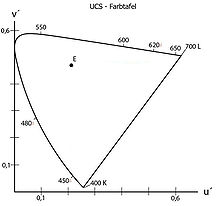- Uniform Color Scale
-
Die CIE-UCS-Farbtafel ist eine Farbtafel. Die CIE-Normfarbtafel ist nicht empfindungsgemäß, wie MacAdam 1940 in einem Experiment beweisen konnte. Das bedeutet dass die Farbtafel zwar korrekt zur mathematischen Beschreibung von Farben ist, jedoch nicht auf die farbliche Wahrnehmung des menschlichen Auges abgestimmt ist. Wenn man zwei Farben gleicher Helligkeit misst, dann spricht man von einem wahrnehmbaren Farbabstand - die Farbabstandsschwelle.
Beschreibung
MacAdam konnte zeigen, dass die Farbabstandsschwelle in der Normfarbtafel die Form von Ellipsen aufweist (um den Faktor 10 vergrößert dargestellt). Diese zeigen, wie stark sich jeweils zwei Farbreize unterscheiden müssen, damit der Farbabstand für das Auge sichtbar wird. Die grünen Farben nehmen im Farbraum einen sehr weiten Raum ein, der Rot- und der Blaubereich sind kleiner.
Durch Verzerren der Normfarbtafel ist die UCS Farbtafel entstanden. Die Ellipsen werden durch mathematische Transformation zu Kreisen verzerrt, um so die Delta E-Gleichabständigkeit annäherend zu erhalten. x und y werden zu u und v transformiert:
Dieses System wurde 1960 in Anlehnung an MacAdam von der CIE übernommen. Um die Gleichabständigkeit zu verbessern, wurde 1976 die uv-Farbtafel in das u'v'-System gewandelt. v wird hierbei um 50% vergrößert:
Anwendung
Die CIE-UCS-Farbtafel sollte bei empfindungsgemäßer Darstellung von Farben verwendet werden. Zu beachten ist jedoch, dass auch diese Farbtafel nur annähernd gleichabständig ist.
Der Farbabstand wird als Euklidischer Abstand ermittelt.
 gibt an wie stark sich zwei Farben empfindungsgemäß voneinander unterscheiden.
gibt an wie stark sich zwei Farben empfindungsgemäß voneinander unterscheiden.mit Δu = u2 − u1 und Δv = v2 − v1
Literatur
- Bergmann, Schaefer: Lehrbuch der Experimentalphysik, Band 3, Optik, Berlin 2004, deGruyter
- E. Dörsam: Farbwiedergabe in den Medien, TUH Darmstadt, Vorlesung WS 08-09
- R. Greule: Skript zur Vorlesung Farbmetrik, HAW-Hamburg
Wikimedia Foundation.






